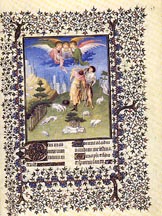

This page comes from a prayer book (Book of Hours) known as the Belles Heures that was made about 1410 for John, the Duke of Berry. The son of John the Good, the King of France, the Duke of Berry was one of the most important patrons of precious objects including tapestries, metalwork, and books. The richness of these objects and exquisite detail are a clear reflection of the taste of this culture that put a heavy priority on material display. We know that the artists of the paintings (miniatures) in the Belles Heures were three brothers known as the Limbourg brothers who had migrated from the northern Netherlands to Paris to seek aristocratic patronage. Documentary evidence suggest that they were not normal practitioners of the trade, but were court artists attached to specific aristocratic households. We will consider in a separate context the role of the court artist. Comparison of this page to other books of the period suggest how the plan of the Belles Heures generally conforms to the general patterns of the book industry. The following is from a page from the so-called St. Maur Hours (Paris, Bibl. nat, nouv. acq. lat 3107):
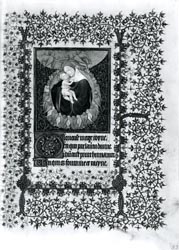
The text is written in the same type of elaborate Gothic script. The initials opening the text and marking textual divisions are the same type. The border decoration composed of painted and gold leaves or rinceaux along with the elaborate framework or staff that surrounds the text are similar. The priority in this production is on standardization of practices and not on uniqueness. Study of the production of book like these reveals a clear subdivision into different specialties. We know that were scribes who were trained to produce the type of formal textual scripts found in these books. Comparably there were decorators trained to produce the type of text and border decoration found in these examples. The paintings or miniatures were in turn generally the responsibility of separate specialists. The training of the different specialists put a heavy priority on conforming to the patterns and standards of the specialty. Standardization of the script and decorative components was essential in maintaining the integrity of the book. This standardization also made it possible for any trained specialist to contribute to the production of the book. Evidence suggests that books like these were not produced in a single workshop but rather the work was sub-divided between a number of different workshops. The centering of the book industry in specific neighborhoods facilitated the collaboration of these different specialists.
In my own research, I have been able to identify the decorator of the pages illustrated above from the Belles Heures and the St. Maur Hours as the same individual whose work can be found in a significant number of other books from the period. The following are samples of this artisans work:
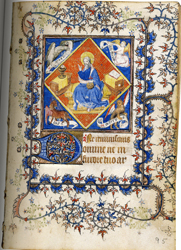 |
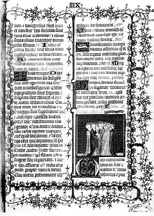 |
|
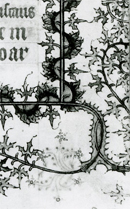 |
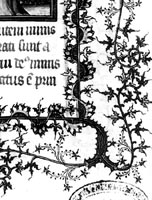 |
As these samples suggest, this artisan employed a standardized repertoire of decorative motifs that he repeated over and over again. My study of the work of this decorator reveals that he rarely collaborated with the same team of artisans in a group of different books. This suggests his independence. Examination of the books he worked on and what he did in these books suggest that he was a highly respected practitioner of the trade, being called on to be frequently the primary decorator in important commissions.
Individuality and uniqueness frequently valued in recent conceptions of the artist were obviously antithetical to late Medieval artistic practice. The artisans success was based on the ability to conform to standardized forms and produce high quality examples. It was essential for the artisan to work successully as part of a collaborative enterprise.